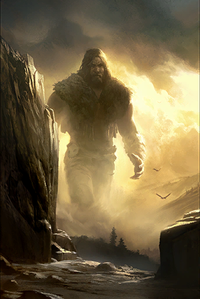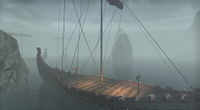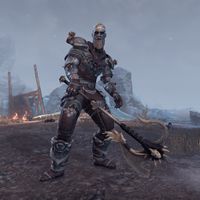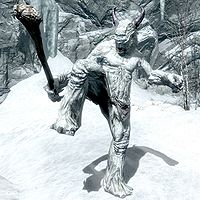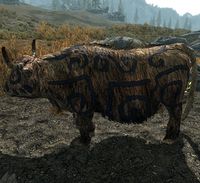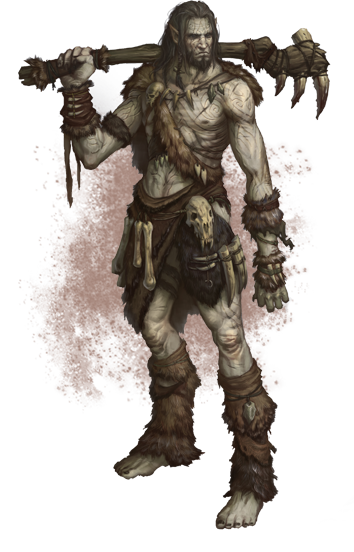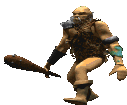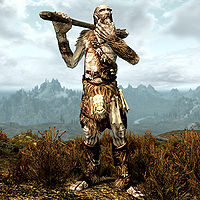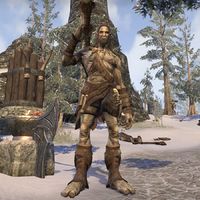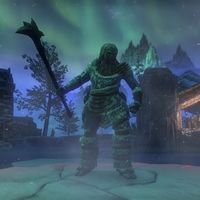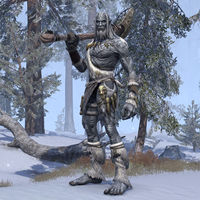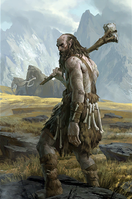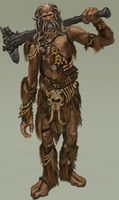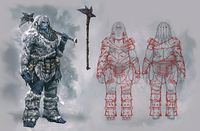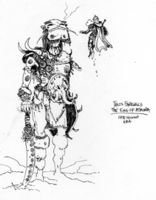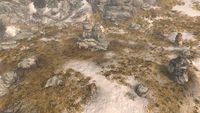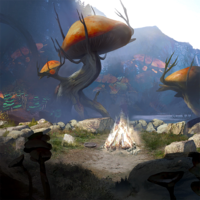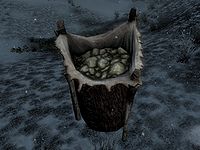Lore:Giant
| Giants | |||
|---|---|---|---|
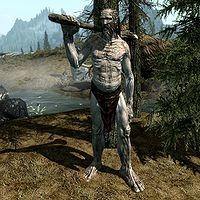 A Giant in Skyrim
A Giant in Skyrim |
|||
| Type | Race (Man) | ||
| Range | Atmora (historically), Cyrodiil, Hammerfell, High Rock, Skyrim, Valenwood (historically) | ||
| Appears in | |||
—Ode To The Tundrastriders
Giants (sometimes called the big folk)[1] are a race of enormous humanoids with colossal strength. They are found in the wilderness of Skyrim, High Rock, Hammerfell, Cyrodiil and Valenwood.[2][3][4][5]
They have thick grey skin, long, powerful limbs, large hands and feet, and thick greyish-brown hair decorated with braids and beads. Additionally, most Giants have decorative scars carved into their chests. They clothe themselves in fur pelts adorned with the bones of animals and people, although many prefer a simple loincloth.[2]
Although they tower above most races, their height can vary. Some stand between 11 and 12 feet tall,[2] whereas others can be several times the height of the average person.[5] Female giants, also called Giantesses, are less commonly seen than males by non-giants,[6][7] and the only known sightings of them have been in the Wrothgarian Mountains and Whiterun Plains during the Second Era.[8][9] Giant social groups appear to vary, with some being part of clans led by a chieftain,[10] some being led by powerful matriarchs,[11] and others being small families composed of two parents raising children together on isolated mountains.[12]
Origins[edit]
The origins of Giants are unclear, conflicting, and sometimes disputed. Although their tapered ears bear a resemblance to that of mer, some scholars believe they actually share an ancestral relationship with the Nords, through the Atmorans.[13] The Atmorans, who were the progenitors of the Nordic race, were said to be originally an intelligent race of ancient giants. The belief is that in ancient times, the Atmorans split into two different races.[13] The reason for the split is unknown, but some accounts mention an internal conflict that resulted in one group being driven into hiding.[UOL 1]
Eventually, one race became smaller in size, but increased in intelligence and became the Nords. The other race grew larger, lost some of their intelligence, and became the Giants.[13] This particular belief thrived in the First Era, at a time when Nordic farmers would offer cows as a sacrifice to Giants in order to avoid attacks on livestock, but both the tradition and the ancestral connection belief largely fell out of favor.[14]
Culture[edit]
Despite their primitive appearances, Giants are moderately intelligent, able to fashion tools and clothes for themselves, tend mammoths, and harness fire. Semi-nomadic, Giants travel with herds of mammoths and set up camps across the lands. Their camps are typically decorated with the skulls and tusks of mammoths, alongside various other bones, some of which are used as tripwire chimes to alert them to any intruders.[2]
For protection, Giants are known to fashion large, crudely-made clubs of stone, wood and bone and even sets of armor.[15][2] They are sometimes seen wearing the skulls of trolls, powerful creatures deadly to many other races, on their belts.[16] Despite their rudimentary craftsmanship, they are one of the few races who know of the techniques required to grind the iron-like tusks of mammoths into powder, a prized alchemical ingredient.[17]
Some Giants belong to a clan, sometimes numbering in the hundreds, which is ruled by a high chieftain.[10] The clan chieftain's rule is absolute, and in times of conflict, they are known to rally their troops and lead organized attacks. If the chieftain is killed, their followers are often left in disarray.[18] Giants have also been observed as having matriarchies, where a giantess has the highest authority.[19]
Giants typically have a deep and guttural speech, sometimes called Giantish.[20] To the average person it sounds like incomprehensible grunts and roars. Giants tend to be non-hostile to speakers of Giantish.[2][3] Some Giants, however, have learned to speak rudimentary Tamrielic in order to communicate or trade with people,[21] and a select few have worked with other races as volunteer gladiators or guards.[22][23] Although Giants have no known written language, they seem to have an affinity for spiral motifs. This particular pattern (shared by ancient Nordic craftsmanship) is often depicted as scars on their torsos, carved into their mammoth's tusks, or painted onto various rocks, trees, and walls within their encampments.[2] Observers have speculated that this rudimentary art possibly entices females, marks territory, or is simply artistic expression.[6]
While it's commonly believed that Giants herd mammoths,[24] scholars have observed that their relationship is based more on mutual respect.[13] They are seemingly able to communicate with mammoths and protect them fiercely. In return, Giants receive companionship and milk, which they process into cheese.[13] Their omnivorous diet also consists of cooked skeever meat, and other animals which they spit-roast over their massive campfires.[2] Some accounts claim to have witnessed a Giant eat a mammoth, but the meal was conducted with reverence.[13] Some giants are claimed to have eaten members of other races.[25][26]
Giants have been known to gather regularly at a ceremonial site. Here, they come together to trade, mate, and communicate with whatever methods they have developed.[13] One tale tells of a Giant family residing on Mount Trolhetta.[12] Giants also demonstrate intricate beliefs regarding death. They have places set aside as sacred burial grounds, such as Secunda's Kiss in Skyrim.[27] When a Giant is sick or dying, he or she goes to one of these places to die. If a Giant dies elsewhere, other Giants make sure the body gets to the burial ground. They typically don't live near these sacred locations, and they don't guard them. They simply make use of them.[13]
Types[edit]
Sea Giants[edit]
Sea Giants are a species of Giant with silvery blue skin that are rarely seen on Tamriel. They're perceived as smarter and more malicious than Giants that dwell on land. Sea Giants are rare enough to be creatures of legend, and have appeared in Nord maritime tales dating back to the First Era. Little is known about their culture and behavior. They are capable of speech, and have been witnessed speaking their own language as well as common dialects such as Tamrielic. Sailors have claimed to witness Sea Giant vessels in the frozen wastes of the Sea of Ghosts. These ships are the size of islands, and are armed with jagged spears. However, these accounts are considered to be widely exaggerated. They allegedly only make landfall during the coldest winters, and never stay for long. They slaughter and pillage, then vanish in the ice and fog.
Half-Giants[edit]
Half-Giants are the descendants of Men and Giants or Sea Giants. They take on the qualities of their mixed heritage, which can be passed down to their descendants. Half-Giants tend to be much taller then the other races, but not nearly as tall as their Giant forebears, with some exceptions.
Sinmur, also known as Sinmur the Terrible and the Giant of Legend, was a Merethic Era Half-Giant chieftain from Skyrim. Leading hundreds of his kin, he is perhaps best remembered for his epic conflict against Ysgramor and the Five Hundred Companions.
Circa 2E 582, Half-Giant and Sea Giant raiders led by Vampire Lord Falgravn stormed the shores of Kyne's Aegis, but were defeated by a group of Undaunted.
Other "Giants"[edit]
There exist several creatures that are related to giants, or are given the description of giants but are not related.
Legends abound of a race of giants known as Hill Giants[UOL 2] from Skyrim that migrated to the present day region of Rivenspire in High Rock, bringing along their massive mammoths. Though they are no longer around, giant remains found within the cavern system of Breagha-Fin in the region gives credence to these tales.[28][29] Legends in the region speak of the "trammeling" of the giants long ago.[30] The artifact Chrysamere was used in a protracted siege of the Fellthunder Clan of giants in Rivenspire early in High Rock's history.[31]
Frost Giants are a sentient race called the "even more formidable cousins of Giants",[32] and are classified with them.[33] Though it is unknown how closely related they are. Similarly, the Ilyadi were an extinct race of forest-dwelling giants native to the Summerset Isles, known for the multiple eyes which covered their heads.[34][35] Marsh Giants, despite their name and size, are known to be unrelated to Giants, instead being a type of Nature Spirit.[36]
In Elsweyr, the Halls of Colossus was believed to be built in honor of an unspecified race of ancient giants. By the Third Era, these giants had not been seen in the land for many years.[37]
Sand giants are a type of giant witnessed around the Craglorn region of Hammerfell.[38]
Atmoran Titans are a group that have been mentioned as similar to albeit separate from ancient giants.[39]
Relationship with Nords[edit]
Giants share little civil interaction with humans or elves, but are typically free to wander through the lands they inhabit. Giants are wary of, but used to, the presence of other races. They are mostly harmless and keep to themselves when unprovoked, but are also very territorial and will react aggressively on intruding adventurers or wild animals.[6][40] If provoked, they have been known to fling unlucky intruders up to a league away with their clubs, and some Giants keep trophies from slain invaders.[18][6]
Because Giants have been relatively common throughout Skyrim since time immemorial, their relationship with the Nords is the most prominent and varies greatly. The Merethic Era was a particularly violent time, according to the earliest accounts. They tell of a powerful Giant named Sinmur who served as the high chieftain of Skyrim's giantish clans.[41] Ysgramor, in his prolonged military expansions into Skyrim, waged war against Sinmur and the Giant clans. Ysgramor purportedly slaughtered hundreds of Giants, and eventually Sinmur himself.[10] Despite the early conflicts with Nords, the presence of Giants remained throughout the province in the eras that followed, although both races largely kept to themselves.
Giants have sometimes been characterized by Nordic villagers as "angry hermits" who attack trespassers on sight. This has resulted in them barricading the pathways leading into the Giant's settlements, preventing anyone from accidentally wandering into the area.[42] Some Nords treat the Giants as a nuisance, steal their grazing lands, and even hunt their mammoths for sport.[13] During the Alliance War in the Second Era, a clan of Giants went to war with the Stormfist Clan over stolen territory and mammoths.[43] During the Stormcloak Rebellion in Skyrim, a clan of Giants who were driven out of their lands began to attack settlements as a result.[44]
Both the Companions and the Fighters Guild readily accept contracts to deal with Giants that have been troubling the population.[45][46] Similarly, the Jarls of Skyrim have been known to send their forces out to kill a Giant that has wandered too close to a settlement.[47] While it may seem the aggressors are almost always the Nords, Giants sometimes play a part in disrupting the peace. Giants can sense weakness and intrude on territory if the opportunity presents itself.[48] They sometimes take livestock from farms, or on rare occasions steal valuable items from the populace.[45] If led by a chieftain, they can be particularly dangerous in large numbers.[49] Ancient parchments speak of the warrior Rolf the Large being killed fighting giants that waylaid his village and proceeded to play catch with his head.[50]
Conversely, other Nords are content to have Giants living within their borders. Some even consider them as distant cousins that should be respected,[13] or write poetry honoring them.[51] Some Nordic farmers uphold a long-standing, albeit uncommon, tradition of annually offering cows as a sacrifice to nearby Giants in order to avoid attacks on livestock. Traditionally, the cows are painted with swirls Giants are so fond of, so that they recognize them as peace offerings.[52][UOL 1] In the Fourth Era, Giants were viewed as a serious problem in the Pale region of Skyrim, but the Empire decreed they be left alone.[53] Certain Giants have been given special permission to keep their campsites, but disturbing or trading with them is forbidden.[54]
Certain Giant body parts are known to be valuable alchemical ingredients and are much sought after by apothecaries, specifically the toes, thumbs and molars. Because the freshness and condition of the body parts are important, some alchemists have drafted harvesting guidelines for enterprising adventurers who may have recently slain a Giant. The benefits that Giant's body parts provide in both potions and enchantments are numerous. Giant's toes can bolster health and strength, at the cost of weakening stamina. Molars are known to bolster combat abilities, and thumbs can imbue a weapon with a pestilent vapor.[55][2] Less common is the consumption of Giant's blood, which results in diminution.[3] A fungus purportedly grows in the Giant's armpits that can be used as a strong narcotic.[56]
Giants, albeit very rarely, are able to reproduce with humans. One such example of this is Lyris Titanborn, a half-Giant Nord who claims to have Giantish ancestry. It is unknown whether or not they are able to reproduce with mer or even the other races of men.[57] The erotic charade "The King and the Amorous Giantess" is sometimes enacted with sets of bedroom stilts and large furry mittens.[58]
Language[edit]
A few words and phrases spoken by Second Era Giants are known, presumably in Giantish. At least one word, 'grool', is shared with the Sea Giant language, but the relationship between the two tongues is unknown. The following words and sentences are known to be used:
Known Words[edit]
Known Sentences[edit]
Gallery[edit]
-
Lyris Titanborn, a Nord of giant ancestry (ESO)
Notes[edit]
- According to Nordic myth, Ysgramor was said to have collected the laments of the "Giant-Wives" while in Atmora, and had them twisted into a bowstring for his fabled bow.[66]
- Some scholars believe that the term "Dwarves" is of Giantish origins, and one that was used in affection towards the Dwemer, whom they perceived as unusually small.[63]
- Talos purportedly traveled to Atmora in the late Second Era and met a Giant who was said to be the king of Atmora.[UOL 3]
- Giants are, by most accounts, related to Men. One source referring to them as Betmeri incorrectly calls them one of the "smaller Beast races".[67]
- Artist Jonah Lobe, who created the model of Giants for Skyrim, said this in regards to his design of the Giants: "I modeled the Giants to look like my father. Yes, I'm that guy. I didn't want the player to see them as monstrous, I wanted to look gentle, like oversized shepherds who lived for two hundred plus years, and slept under the stars."[UOL 4]
- A cut mission from Skyrim's Civil War questline would have had the player bring a Giant named Goldar a Painted Cow as peace offering, an old tradition from when there were more Giants in the world. Goldar is rather cordial in response to this gift, and becomes an ally of the player. Goldar, and the Cow Hand (who gives the player the Painted Cow) implicate that the Giants could be on more peaceful terms with their neighbors if they were not ostracized, and that the Giants were "allowed" before.[UOL 5] The Painted Cow concept itself made it into the final game; the player may find farmers in random encounters on journeys to present their Cow to the Giants as a peace offering to cease attacks on their farms, the time between offerings depending on what an individual farmer thinks best.[68] This worldbuilding item was adopted from unofficial lore, this being: The Seven Fights of Aldudagga, by Michael Kirkbride written in 2005.[UOL 6]
See Also[edit]
- Giant Names
- For a list of notable Giants, see here.
- For game-specific information, see the Daggerfall, Skyrim, Elder Scrolls Online, and Legends articles.
Books[edit]
- All About Giants by Bonorion the Wanderer — Observations on the Giantish Peoples of Skyrim
- Ode To The Tundrastriders by Unknown — A poem dedicated to giants
- Giants: A Discourse by Kord the Curious — A treatise on the Giants of Skyrim
- Songs of the Return, Volume 27 — Part of the traditional legend of Ysgramor and his Five Hundred Companions
References[edit]
- ^ Aspera Giant-Friend's dialogue in ESO
- ^ a b c d e f g h i Events of Skyrim
- ^ a b c Events of Daggerfall
- ^ Pocket Guide to the Empire, 3rd Edition: The Wilds Remain: Valenwood — Imperial Geographical Society, 3E 432
- ^ a b Events of ESO
- ^ a b c d All About Giants — Bonorion the Wanderer
- ^ Hags, Harpies, and Hagravens — The Unveiled Azadiyeh, Songbird of Satakalaam
- ^ Matriarch Runa in the Maelstrom Arena
- ^ Meet the Character - Eerika Skjoralmor — Torik
- ^ a b c Songs of the Return, Volume 27
- ^ Matriarch Aldis in Plans of Pestilence
- ^ a b The Silver Werewolf — Hildegard
- ^ a b c d e f g h i j Giants: A Discourse — Kord the Curious
- ^ The Improved Emperor's Guide to Tamriel: Skyrim
- ^ The Horror of Castle Xyr — Baloth-Kul
- ^ Grok's outfit in Skyrim
- ^ Quintus Navale's dialogue in Skyrim
- ^ a b Centurion Gjakil's dialogue in ESO
- ^ Jorvuld Davaux's dialogue in ESO: Dragon Bones
- ^ Giantish language skill in Daggerfall
- ^ Pack of Giants quest in Daggerfall
- ^ Events of Mephala's Quest in Daggerfall
- ^ Grunt the Clever's dialogue in ESO
- ^ Loading screen in Skyrim
- ^ Pack of Giants quest in Daggerfall
- ^ Giant Killing quest in Daggerfall
- ^ Guard's dialogue in Skyrim
- ^ Barrowton's Journal — Barrowton
- ^ Breagha-Fin's loading screen in ESO
- ^ Shornhelm, Crown City of the North — Lord Wylon, 39th Baron Montclair
- ^ Loremaster's Archive - Infinite Archive — Master Malkhest
- ^ The Elder Scrolls V: Skyrim: Prima Official Game Guide — David Hodgson
- ^ Giant creature type in Legends
- ^ Pocket Guide to the Empire, 3rd Edition: The Blessed Isle: Alinor and the Summersets — Imperial Geographical Society, 3E 432
- ^ The Improved Emperor's Guide to Tamriel: Summerset Isles
- ^ On Marsh Giants: A Study — Fanemil, Associate Dean of Plant Studies, University of Gwylim
- ^ Ria Silmane's dialogue in Arena
- ^ Slonn Clod-Kicker's dialogue in ESO
- ^ Letter to Thane Ogvar — Thunvilde
- ^ From the journal of Logang Foxbite — Logang Foxbite
- ^ Skald Svari's dialogue in ESO
- ^ Into the Lion's Den
- ^ Strange Allies quest in ESO
- ^ Farkas' dialogue in Skyrim
- ^ a b Family Heirloom quest in Skyrim
- ^ Giant Killing quest in Daggerfall
- ^ Skyrim's Rule — Abdul-Mujib Ababneh
- ^ Atub's dialogue in Skyrim
- ^ The Farmer's Champion quest in ESO
- ^ Sovngarde, a Reexamination — Bereditte Jastal
- ^ Ode To The Tundrastriders — Unknown
- ^ Farmer's dialogue in Skyrim
- ^ Skald's dialogue in Skyrim
- ^ Official warning
- ^ Agents and Reagents: The Bounty of Mundus
- ^ Nobleman's dialogue in Skyrim: Dawnguard
- ^ Lyris Titanborn's dialogue in ESO
- ^ "Amorous Giantess" Royal Ensemble item description in ESO
- ^ a b c d e f g Matriarch Runa's dialogue in ESO: Orsinium
- ^ a b c d e f g h i j Vigi's dialogue in ESO: Orsinium
- ^ a b c d e Matriarch Aldis' dialogue in ESO: Dragon Bones
- ^ a b c d e f g h i j k l Kjarg the Tuskscraper's dialogue in ESO: Harrowstorm
- ^ a b Hasphat Antabolis' dialogue in Morrowind
- ^ a b c d e f g Aki's dialogue in ESO: Orsinium
- ^ a b c Bor's dialogue in ESO: Orsinium
- ^ Fragmentae Abyssum Hermaeus Morus
- ^ Betmeri dialogue topic in Morrowind
- ^ Skyrim World Interactions
Note: The following references are considered to be unofficial sources. They are included to round off this article and may not be authoritative or conclusive.
- ^ a b The Seven Fights of The Aldudagga: Fight Six, "The 911th Cow"
- ^ Hill Giants mentioned as the giant species in Breagha-Fin
- ^ Talos Farewells the King of Atmora — Michael Kirkbride
- ^ You're Finally Awake: Nine Developers Recount the Making of Skyrim
- ^ Skyrim Unfinished Quests
- ^ Kurt Kuhlmann's Posts
|
|||||||||||||||||||||||||||||||||||||||||||
